wheel FIAT FIORINO 2010 Owner handbook (in English)
[x] Cancel search | Manufacturer: FIAT, Model Year: 2010, Model line: FIORINO, Model: FIAT FIORINO 2010Pages: 210, PDF Size: 4.9 MB
Page 75 of 210
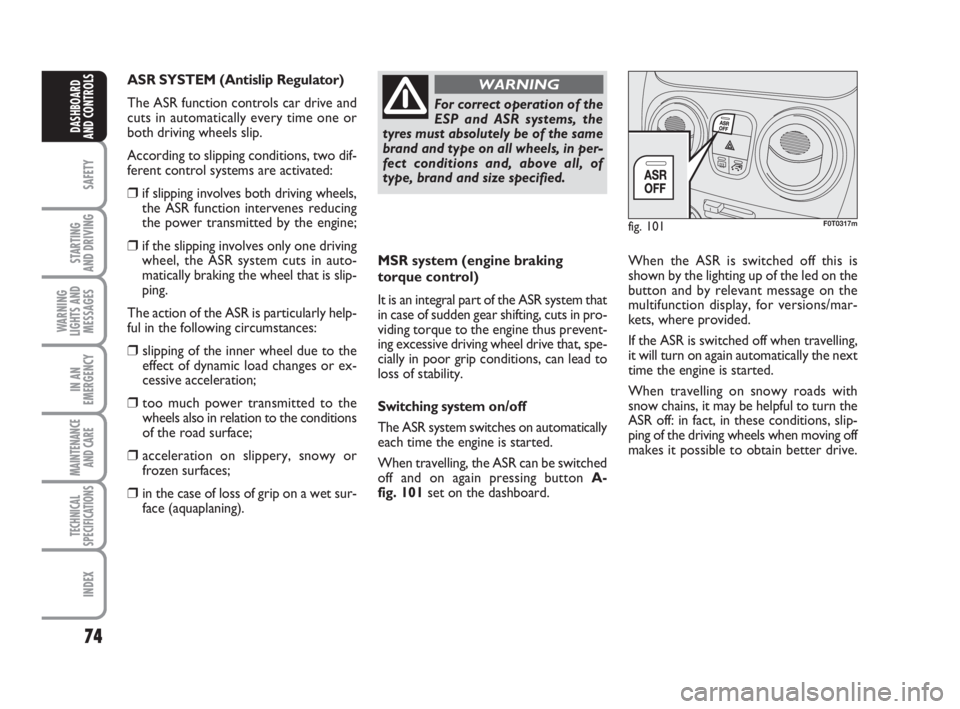
74
SAFETY
STARTING
AND DRIVING
WARNING
LIGHTS AND
MESSAGES
IN AN
EMERGENCY
MAINTENANCE
AND CARE
TECHNICAL
SPECIFICATIONS
INDEX
DASHBOARD
AND CONTROLS
MSR system (engine braking
torque control)
It is an integral part of the ASR system that
in case of sudden gear shifting, cuts in pro-
viding torque to the engine thus prevent-
ing excessive driving wheel drive that, spe-
cially in poor grip conditions, can lead to
loss of stability.
Switching systemon/off
The ASR system switches on automatically
each time the engine is started.
When travelling, the ASR can be switched
off and on again pressing button A-
fig. 101set on the dashboard. When the ASR is switched off this is
shown by the lighting up of the led on the
button and by relevant message on the
multifunction display, for versions/mar-
kets, where provided.
If the ASR is switched off when travelling,
it will turn on again automatically the next
time the engine is started.
When travelling on snowy roads with
snow chains, it may be helpful to turn the
ASR off: in fact, in these conditions, slip-
ping of the driving wheels when moving off
makes it possible to obtain better drive.
For correct operation of the
ESP and ASR systems, the
tyres must absolutely be of the same
brand and type on all wheels, in per-
fect conditions and, above all, of
type, brand and size specified.
WARNING
fig. 101F0T0317m
ASR SYSTEM (Antislip Regulator)
The ASR function controls car drive and
cuts in automatically every time one or
both driving wheels slip.
According to slipping conditions, two dif-
ferent control systems are activated:
❒if slipping involves both driving wheels,
the ASR function intervenes reducing
the power transmitted by the engine;
❒if the slipping involves only one driving
wheel, the ASR system cuts in auto-
matically braking the wheel that is slip-
ping.
The action of the ASR is particularly help-
ful in the following circumstances:
❒ slipping of the inner wheel due to the
effect of dynamic load changes or ex-
cessive acceleration;
❒ too much power transmitted to the
wheels also in relation to the conditions
of the road surface;
❒ acceleration on slippery, snowy or
frozen surfaces;
❒ in the case of loss of grip on a wet sur-
face (aquaplaning).
036-082 Fiorino GB 1ed:036-082 Fiorino GB 1ed 30-11-2009 15:47 Pagina 74
Page 76 of 210
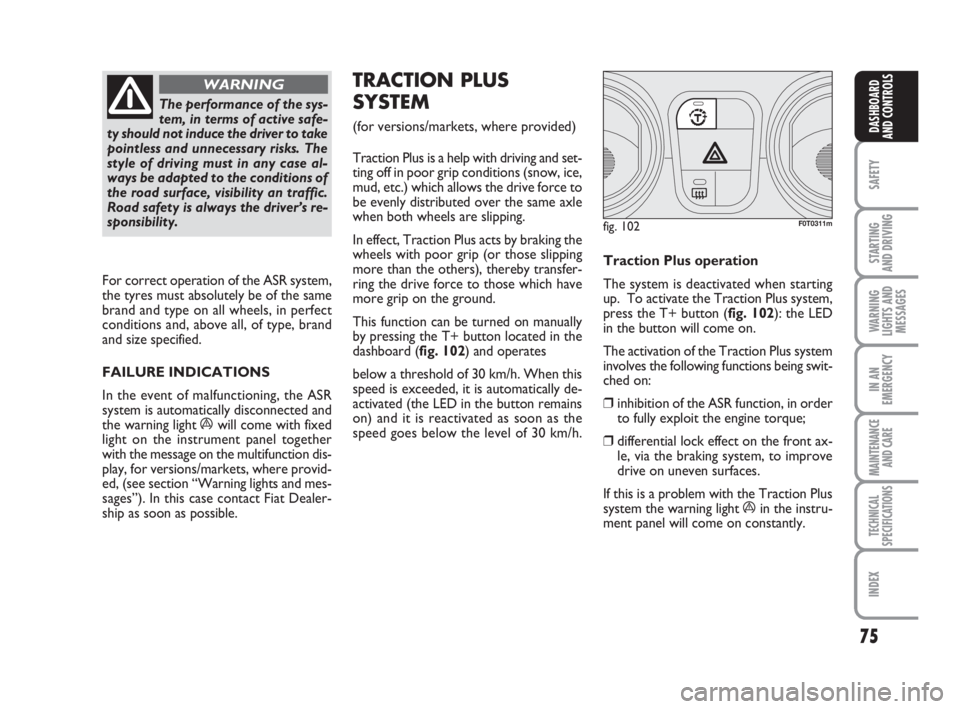
75
SAFETY
STARTING
AND DRIVING
WARNING
LIGHTS AND
MESSAGES
IN AN
EMERGENCY
MAINTENANCE
AND CARE
TECHNICAL
SPECIFICATIONS
INDEX
DASHBOARD
AND CONTROLS
The performance of the sys-
tem, in terms of active safe-
ty should not induce the driver to take
pointless and unnecessary risks. The
style of driving must in any case al-
ways be adapted to the conditions of
the road surface, visibility an traffic.
Road safety is always the driver’s re-
sponsibility.
WARNING
For correct operation of the ASR system,
the tyres must absolutely be of the same
brand and type on all wheels, in perfect
conditions and, above all, of type, brand
and size specified.
FAILURE INDICATIONS
In the event of malfunctioning, the ASR
system is automatically disconnected and
the warning light
áwill come with fixed
light on the instrument panel together
with the message on the multifunction dis-
play, for versions/markets, where provid-
ed, (see section “Warning lights and mes-
sages”). In this case contact Fiat Dealer-
ship as soon as possible.
TRACTION PLUS
SYSTEM
(for versions/markets, where provided)
Traction Plus is a help with driving and set-
ting off in poor grip conditions (snow, ice,
mud, etc.) which allows the drive force to
be evenly distributed over the same axle
when both wheels are slipping.
In effect, Traction Plus acts by braking the
wheels with poor grip (or those slipping
more than the others), thereby transfer-
ring the drive force to those which have
more grip on the ground.
This function can be turned on manually
by pressing the T+ button located in the
dashboard (fig. 102) and operates
below a threshold of 30 km/h. When this
speed is exceeded, it is automatically de-
activated (the LED in the button remains
on) and it is reactivated as soon as the
speed goes below the level of 30 km/h.Traction Plus operation
The system is deactivated when starting
up. To activate the Traction Plus system,
press the T+ button (fig. 102): the LED
in the button will come on.
The activation of the Traction Plus system
involves the following functions being swit-
ched on:
❒inhibition of the ASR function, in order
to fully exploit the engine torque;
❒differential lock effect on the front ax-
le, via the braking system, to improve
drive on uneven surfaces.
If this is a problem with the Traction Plus
system the warning light
áin the instru-
ment panel will come on constantly.
fig. 102F0T0311m
036-082 Fiorino GB 1ed:036-082 Fiorino GB 1ed 30-11-2009 15:47 Pagina 75
Page 97 of 210
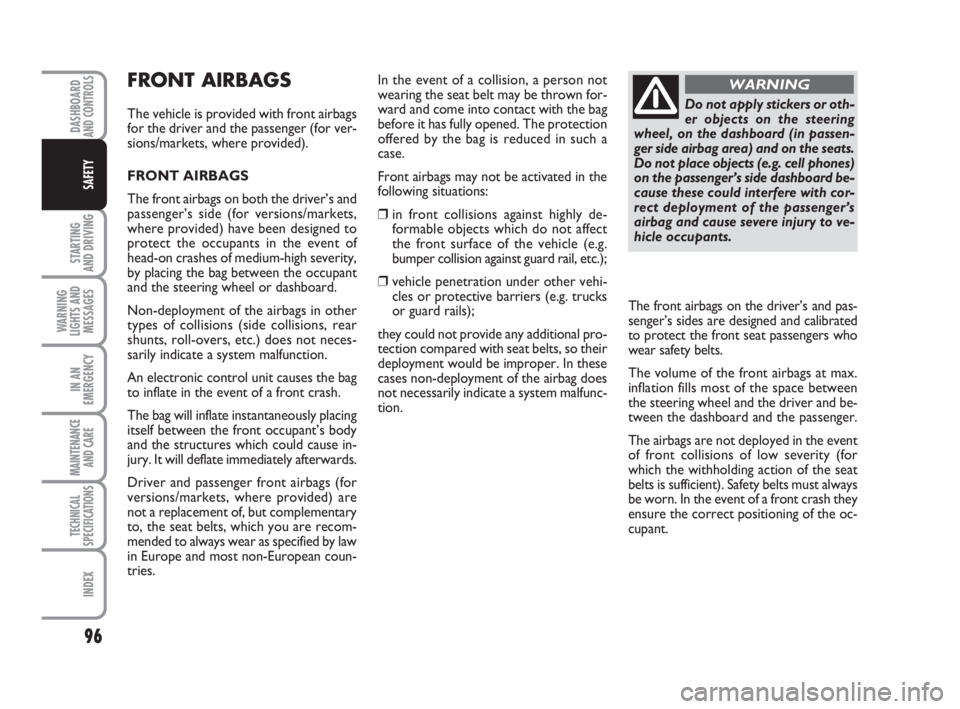
96
STARTING
AND DRIVING
WARNING
LIGHTS AND
MESSAGES
IN AN
EMERGENCY
MAINTENANCE
AND CARE
TECHNICAL
SPECIFICATIONS
INDEX
DASHBOARDAND CONTROLS
SAFETY
FRONT AIRBAGS
The vehicle is provided with front airbags
for the driver and the passenger (for ver-
sions/markets, where provided).
FRONT AIRBAGS
The front airbags on both the driver’s and
passenger’s side (for versions/markets,
where provided) have been designed to
protect the occupants in the event of
head-on crashes of medium-high severity,
by placing the bag between the occupant
and the steering wheel or dashboard.
Non-deployment of the airbags in other
types of collisions (side collisions, rear
shunts, roll-overs, etc.) does not neces-
sarily indicate a system malfunction.
An electronic control unit causes the bag
to inflate in the event of a front crash.
The bag will inflate instantaneously placing
itself between the front occupant’s body
and the structures which could cause in-
jury. It will deflate immediately afterwards.
Driver and passenger front airbags (for
versions/markets, where provided) are
not a replacement of, but complementary
to, the seat belts, which you are recom-
mended to always wear as specified by law
in Europe and most non-European coun-
tries.In the event of a collision, a person not
wearing the seat belt may be thrown for-
ward and come into contact with the bag
before it has fully opened. The protection
offered by the bag is reduced in such a
case.
Front airbags may not be activated in the
following situations:
❒in front collisions against highly de-
formable objects which do not affect
the front surface of the vehicle (e.g.
bumper collision against guard rail, etc.);
❒vehicle penetration under other vehi-
cles or protective barriers (e.g. trucks
or guard rails);
they could not provide any additional pro-
tection compared with seat belts, so their
deployment would be improper. In these
cases non-deployment of the airbag does
not necessarily indicate a system malfunc-
tion.Do not apply stickers or oth-
er objects on the steering
wheel, on the dashboard (in passen-
ger side airbag area) and on the seats.
Do not place objects (e.g. cell phones)
on the passenger’s side dashboard be-
cause these could interfere with cor-
rect deployment of the passenger’s
airbag and cause severe injury to ve-
hicle occupants.
WARNING
The front airbags on the driver’s and pas-
senger’s sides are designed and calibrated
to protect the front seat passengers who
wear safety belts.
The volume of the front airbags at max.
inflation fills most of the space between
the steering wheel and the driver and be-
tween the dashboard and the passenger.
The airbags are not deployed in the event
of front collisions of low severity (for
which the withholding action of the seat
belts is sufficient). Safety belts must always
be worn. In the event of a front crash they
ensure the correct positioning of the oc-
cupant.
083-100 Fiorino GB 1ed:083-100 Fiorino GB 1ed 30-11-2009 15:53 Pagina 96
Page 98 of 210
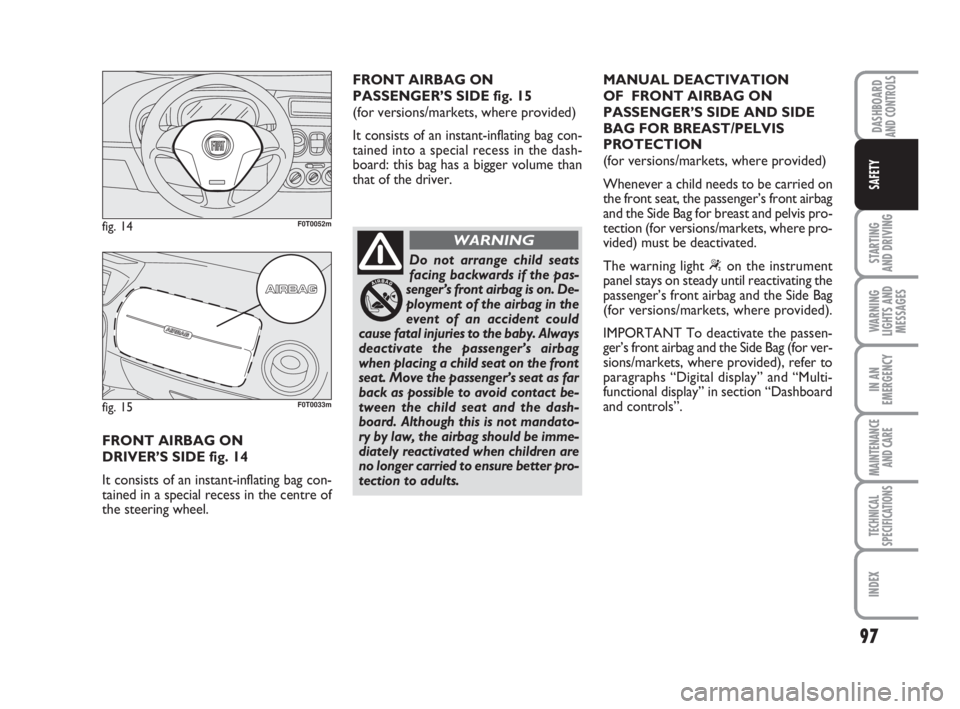
97
STARTING
AND DRIVING
WARNING
LIGHTS AND
MESSAGES
IN AN
EMERGENCY
MAINTENANCE
AND CARE
TECHNICAL
SPECIFICATIONS
INDEX
DASHBOARDAND CONTROLS
SAFETY
FRONT AIRBAG ON
DRIVER’S SIDE fig. 14
It consists of an instant-inflating bag con-
tained in a special recess in the centre of
the steering wheel.
fig. 14F0T0052m
fig. 15F0T0033m
FRONT AIRBAG ON
PASSENGER’S SIDE fig. 15
(for versions/markets, where provided)
It consists of an instant-inflating bag con-
tained into a special recess in the dash-
board: this bag has a bigger volume than
that of the driver.
Do not arrange child seats
facing backwards if the pas-
senger’s front airbag is on. De-
ployment of the airbag in the
event of an accident could
cause fatal injuries to the baby. Always
deactivate the passenger’s airbag
when placing a child seat on the front
seat. Move the passenger’s seat as far
back as possible to avoid contact be-
tween the child seat and the dash-
board. Although this is not mandato-
ry by law, the airbag should be imme-
diately reactivated when children are
no longer carried to ensure better pro-
tection to adults.
WARNING
MANUAL DEACTIVATION
OF FRONT AIRBAG ON
PASSENGER’S SIDE AND SIDE
BAG FOR BREAST/PELVIS
PROTECTION
(for versions/markets, where provided)
Whenever a child needs to be carried on
the front seat, the passenger’s front airbag
and the Side Bag for breast and pelvis pro-
tection (for versions/markets, where pro-
vided) must be deactivated.
The warning light
“on the instrument
panel stays on steady until reactivating the
passenger’s front airbag and the Side Bag
(for versions/markets, where provided).
IMPORTANT To deactivate the passen-
ger’s front airbag and the Side Bag (for ver-
sions/markets, where provided), refer to
paragraphs “Digital display” and “Multi-
functional display” in section “Dashboard
and controls”.
083-100 Fiorino GB 1ed:083-100 Fiorino GB 1ed 30-11-2009 15:53 Pagina 97
Page 103 of 210
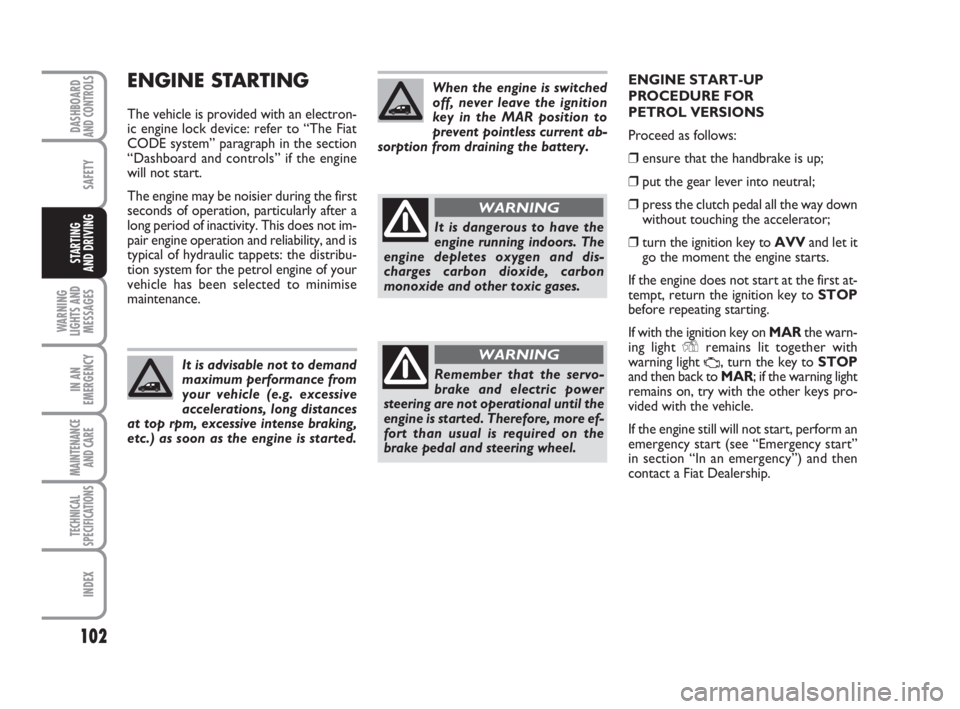
102
SAFETY
WARNING
LIGHTS AND
MESSAGES
IN AN
EMERGENCY
MAINTENANCE
AND CARE
TECHNICAL
SPECIFICATIONS
INDEX
DASHBOARDAND CONTROLS
STARTING
AND DRIVING
ENGINE STARTING
The vehicle is provided with an electron-
ic engine lock device: refer to “The Fiat
CODE system” paragraph in the section
“Dashboard and controls” if the engine
will not start.
The engine may be noisier during the first
seconds of operation, particularly after a
long period of inactivity. This does not im-
pair engine operation and reliability, and is
typical of hydraulic tappets: the distribu-
tion system for the petrol engine of your
vehicle has been selected to minimise
maintenance.ENGINE START-UP
PROCEDURE FOR
PETROL VERSIONS
Proceed as follows:
❒ensure that the handbrake is up;
❒put the gear lever into neutral;
❒press the clutch pedal all the way down
without touching the accelerator;
❒turn the ignition key to AVVand let it
go the moment the engine starts.
If the engine does not start at the first at-
tempt, return the ignition key to STOP
before repeating starting.
If with the ignition key on MARthe warn-
ing light Yremains lit together with
warning light
U, turn the key to STOP
and then back to MAR; if the warning light
remains on, try with the other keys pro-
vided with the vehicle.
If the engine still will not start, perform an
emergency start (see “Emergency start”
in section “In an emergency”) and then
contact a Fiat Dealership. It is advisable not to demand
maximum performance from
your vehicle (e.g. excessive
accelerations, long distances
at top rpm, excessive intense braking,
etc.) as soon as the engine is started.
When the engine is switched
off, never leave the ignition
key in the MAR position to
prevent pointless current ab-
sorption from draining the battery.
Remember that the servo-
brake and electric power
steering are not operational until the
engine is started. Therefore, more ef-
fort than usual is required on the
brake pedal and steering wheel.
WARNING
It is dangerous to have the
engine running indoors. The
engine depletes oxygen and dis-
charges carbon dioxide, carbon
monoxide and other toxic gases.
WARNING
101-110 Fiorino GB 1ed:101-110 Fiorino GB 1ed 30-11-2009 16:13 Pagina 102
Page 105 of 210
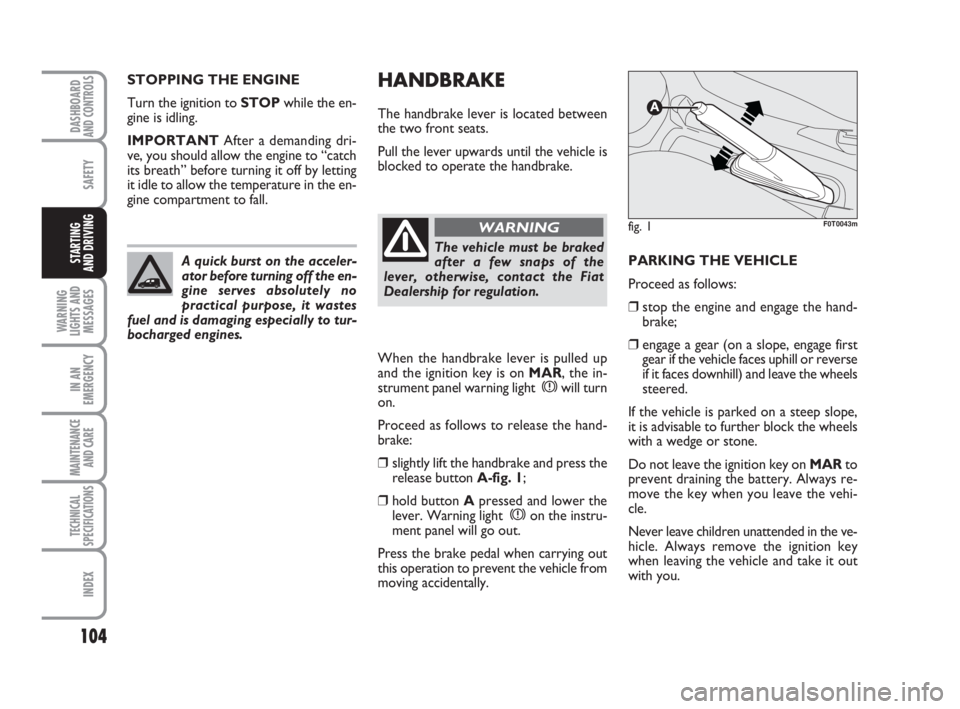
104
SAFETY
WARNING
LIGHTS AND
MESSAGES
IN AN
EMERGENCY
MAINTENANCE
AND CARE
TECHNICAL
SPECIFICATIONS
INDEX
DASHBOARDAND CONTROLS
STARTING
AND DRIVING
HANDBRAKE
The handbrake lever is located between
the two front seats.
Pull the lever upwards until the vehicle is
blocked to operate the handbrake.
When the handbrake lever is pulled up
and the ignition key is on MAR, the in-
strument panel warning light xwill turn
on.
Proceed as follows to release the hand-
brake:
❒slightly lift the handbrake and press the
release button A-fig. 1;
❒hold button Apressed and lower the
lever. Warning light xon the instru-
ment panel will go out.
Press the brake pedal when carrying out
this operation to prevent the vehicle from
moving accidentally.PARKING THE VEHICLE
Proceed as follows:
❒stop the engine and engage the hand-
brake;
❒engage a gear (on a slope, engage first
gear if the vehicle faces uphill or reverse
if it faces downhill) and leave the wheels
steered.
If the vehicle is parked on a steep slope,
it is advisable to further block the wheels
with a wedge or stone.
Do not leave the ignition key on MARto
prevent draining the battery. Always re-
move the key when you leave the vehi-
cle.
Never leave children unattended in the ve-
hicle. Always remove the ignition key
when leaving the vehicle and take it out
with you. STOPPING THE ENGINE
Turn the ignition to STOPwhile the en-
gine is idling.
IMPORTANTAfter a demanding dri-
ve, you should allow the engine to “catch
its breath” before turning it off by letting
it idle to allow the temperature in the en-
gine compartment to fall.
A quick burst on the acceler-
ator before turning off the en-
gine serves absolutely no
practical purpose, it wastes
fuel and is damaging especially to tur-
bocharged engines.
fig. 1F0T0043m
The vehicle must be braked
after a few snaps of the
lever, otherwise, contact the Fiat
Dealership for regulation.
WARNING
101-110 Fiorino GB 1ed:101-110 Fiorino GB 1ed 30-11-2009 16:14 Pagina 104
Page 111 of 210
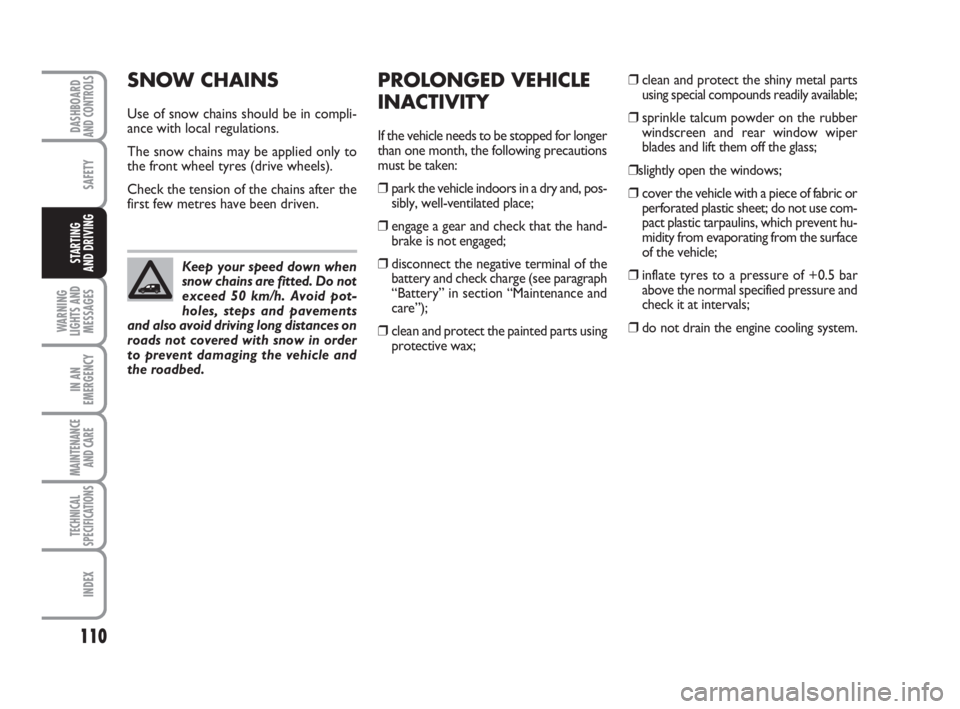
110
SAFETY
WARNING
LIGHTS AND
MESSAGES
IN AN
EMERGENCY
MAINTENANCE
AND CARE
TECHNICAL
SPECIFICATIONS
INDEX
DASHBOARDAND CONTROLS
STARTING
AND DRIVING
SNOW CHAINS
Use of snow chains should be in compli-
ance with local regulations.
The snow chains may be applied only to
the front wheel tyres (drive wheels).
Check the tension of the chains after the
first few metres have been driven.
PROLONGED VEHICLE
INACTIVITY
If the vehicle needs to be stopped for longer
than one month, the following precautions
must be taken:
❒park the vehicle indoors in a dry and, pos-
sibly, well-ventilated place;
❒engage a gear and check that the hand-
brake is not engaged;
❒disconnect the negative terminal of the
battery and check charge (see paragraph
“Battery” in section “Maintenance and
care”);
❒clean and protect the painted parts using
protective wax;❒clean and protect the shiny metal parts
using special compounds readily available;
❒sprinkle talcum powder on the rubber
windscreen and rear window wiper
blades and lift them off the glass;
❒slightly open the windows;
❒cover the vehicle with a piece of fabric or
perforated plastic sheet; do not use com-
pact plastic tarpaulins, which prevent hu-
midity from evaporating from the surface
of the vehicle;
❒inflate tyres to a pressure of +0.5 bar
above the normal specified pressure and
check it at intervals;
❒do not drain the engine cooling system. Keep your speed down when
snow chains are fitted. Do not
exceed 50 km/h. Avoid pot-
holes, steps and pavements
and also avoid driving long distances on
roads not covered with snow in order
to prevent damaging the vehicle and
the roadbed.
101-110 Fiorino GB 1ed:101-110 Fiorino GB 1ed 30-11-2009 16:14 Pagina 110
Page 116 of 210
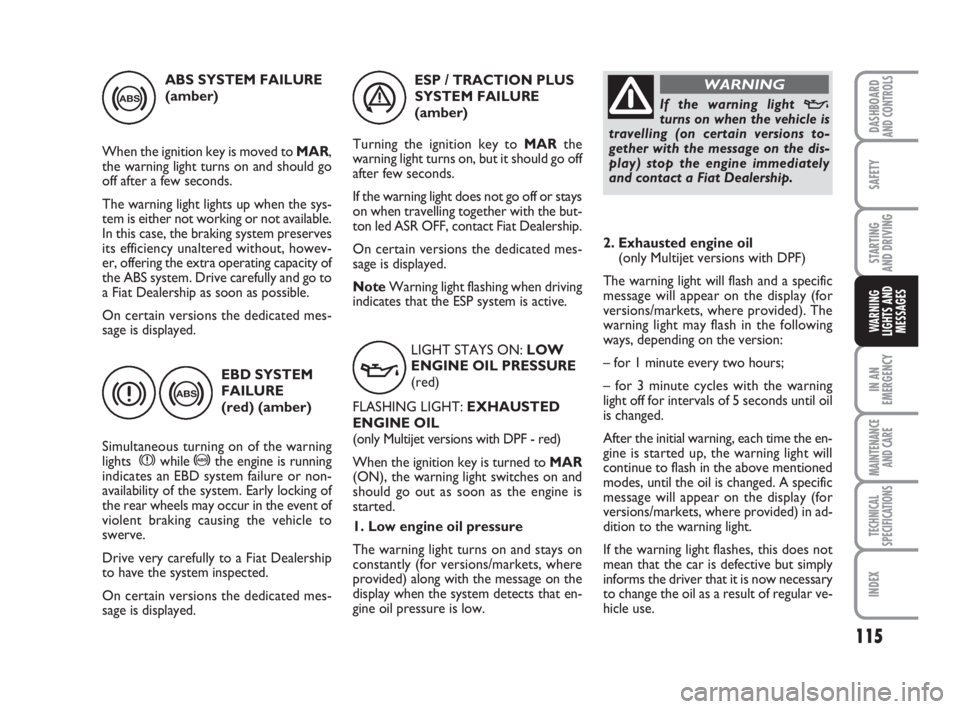
115
SAFETY
IN AN
EMERGENCY
MAINTENANCE
AND CARE
TECHNICAL
SPECIFICATIONS
INDEX
DASHBOARDAND CONTROLS
STARTING
AND DRIVING
WARNING
LIGHTS AND
MESSAGES
ABS SYSTEM FAILURE
(amber)
When the ignition key is moved to MAR,
the warning light turns on and should go
off after a few seconds.
The warning light lights up when the sys-
tem is either not working or not available.
In this case, the braking system preserves
its efficiency unaltered without, howev-
er, offering the extra operating capacity of
the ABS system. Drive carefully and go to
a Fiat Dealership as soon as possible.
On certain versions the dedicated mes-
sage is displayed.
EBD SYSTEM
FAILURE
(red) (amber)
Simultaneous turning on of the warning
lights
xwhile >the engine is running
indicates an EBD system failure or non-
availability of the system. Early locking of
the rear wheels may occur in the event of
violent braking causing the vehicle to
swerve.
Drive very carefully to a Fiat Dealership
to have the system inspected.
On certain versions the dedicated mes-
sage is displayed.
>
x>
v
LIGHT STAYS ON: LOW
ENGINE OIL PRESSURE
(red)
FLASHING LIGHT: EXHAUSTED
ENGINE OIL
(only Multijet versions with DPF - red)
When the ignition key is turned to MAR
(ON), the warning light switches on and
should go out as soon as the engine is
started.
1. Low engine oil pressure
The warning light turns on and stays on
constantly (for versions/markets, where
provided) along with the message on the
display when the system detects that en-
gine oil pressure is low.ESP / TRACTION PLUS
SYSTEM FAILURE
(amber)
Turning the ignition key to MARthe
warning light turns on, but it should go off
after few seconds.
If the warning light does not go off or stays
on when travelling together with the but-
ton led ASR OFF, contact Fiat Dealership.
On certain versions the dedicated mes-
sage is displayed.
NoteWarning light flashing when driving
indicates that the ESP system is active.
áIf the warning light vturns on when the vehicle is
travelling (on certain versions to-
gether with the message on the dis-
play) stop the engine immediately
and contact a Fiat Dealership.
WARNING
2. Exhausted engine oil
(only Multijet versions with DPF)
The warning light will flash and a specific
message will appear on the display (for
versions/markets, where provided). The
warning light may flash in the following
ways, depending on the version:
– for 1 minute every two hours;
– for 3 minute cycles with the warning
light off for intervals of 5 seconds until oil
is changed.
After the initial warning, each time the en-
gine is started up, the warning light will
continue to flash in the above mentioned
modes, until the oil is changed. A specific
message will appear on the display (for
versions/markets, where provided) in ad-
dition to the warning light.
If the warning light flashes, this does not
mean that the car is defective but simply
informs the driver that it is now necessary
to change the oil as a result of regular ve-
hicle use.
111-122 Fiorino GB 1ed:111-122 Fiorino GB 1ed 2-12-2009 16:18 Pagina 115
Page 125 of 210
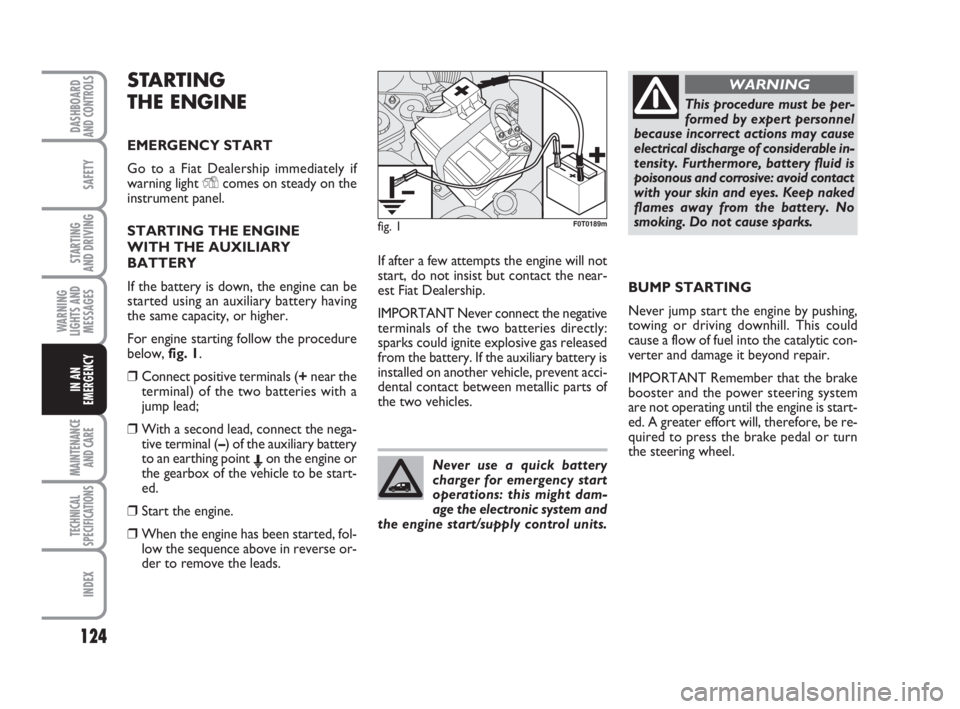
124
SAFETY
MAINTENANCE
AND CARE
TECHNICAL
SPECIFICATIONS
INDEX
DASHBOARDAND CONTROLS
STARTING
AND DRIVING
WARNING
LIGHTS AND
MESSAGES
IN AN
EMERGENCY
STARTING
THE ENGINE
EMERGENCY START
Go to a Fiat Dealership immediately if
warning light Ycomes on steady on the
instrument panel.
STARTING THE ENGINE
WITH THE AUXILIARY
BATTERY
If the battery is down, the engine can be
started using an auxiliary battery having
the same capacity, or higher.
For engine starting follow the procedure
below, fig. 1.
❒Connect positive terminals (+near the
terminal) of the two batteries with a
jump lead;
❒With a second lead, connect the nega-
tive terminal (–) of the auxiliary battery
to an earthing point Eon the engine or
the gearbox of the vehicle to be start-
ed.
❒Start the engine.
❒When the engine has been started, fol-
low the sequence above in reverse or-
der to remove the leads.If after a few attempts the engine will not
start, do not insist but contact the near-
est Fiat Dealership.
IMPORTANT Never connect the negative
terminals of the two batteries directly:
sparks could ignite explosive gas released
from the battery. If the auxiliary battery is
installed on another vehicle, prevent acci-
dental contact between metallic parts of
the two vehicles.BUMP STARTING
Never jump start the engine by pushing,
towing or driving downhill. This could
cause a flow of fuel into the catalytic con-
verter and damage it beyond repair.
IMPORTANT Remember that the brake
booster and the power steering system
are not operating until the engine is start-
ed. A greater effort will, therefore, be re-
quired to press the brake pedal or turn
the steering wheel.
Never use a quick battery
charger for emergency start
operations: this might dam-
age the electronic system and
the engine start/supply control units.
This procedure must be per-
formed by expert personnel
because incorrect actions may cause
electrical discharge of considerable in-
tensity. Furthermore, battery fluid is
poisonous and corrosive: avoid contact
with your skin and eyes. Keep naked
flames away from the battery. No
smoking. Do not cause sparks.
WARNING
fig. 1F0T0189m
123-154 Fiorino GB 1ed:123-154 Fiorino GB 1ed 3-12-2009 15:33 Pagina 124
Page 126 of 210
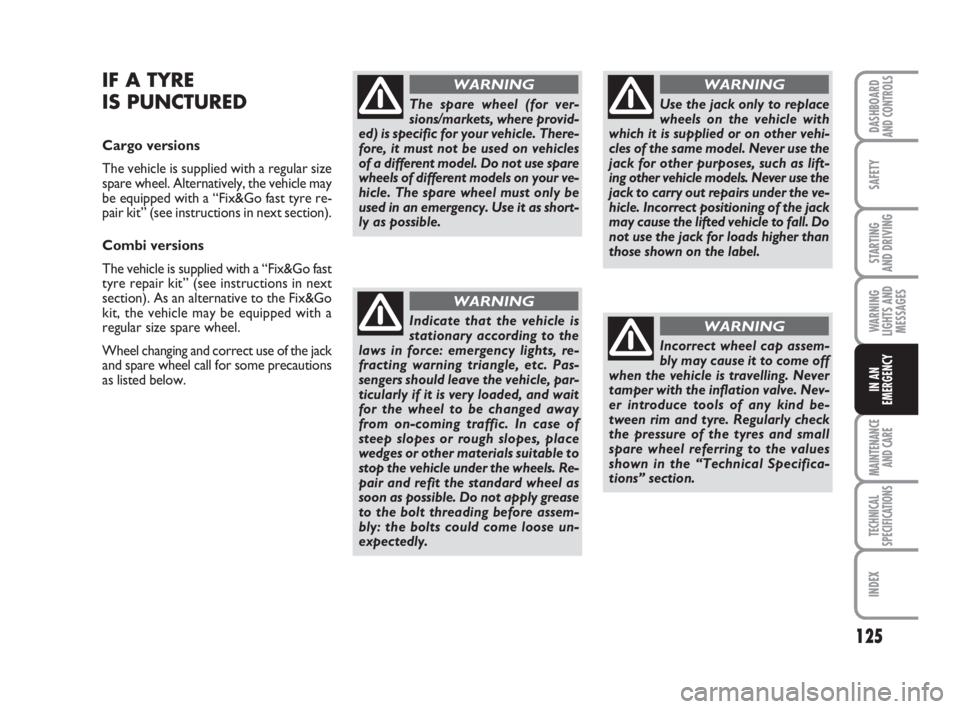
125
SAFETY
MAINTENANCE
AND CARE
TECHNICAL
SPECIFICATIONS
INDEX
DASHBOARDAND CONTROLS
STARTING
AND DRIVING
WARNING
LIGHTS AND
MESSAGES
IN AN
EMERGENCY
IF A TYRE
IS PUNCTURED
Cargo versions
The vehicle is supplied with a regular size
spare wheel. Alternatively, the vehicle may
be equipped with a “Fix&Go fast tyre re-
pair kit” (see instructions in next section).
Combi versions
The vehicle is supplied with a “Fix&Go fast
tyre repair kit” (see instructions in next
section). As an alternative to the Fix&Go
kit, the vehicle may be equipped with a
regular size spare wheel.
Wheel changing and correct use of the jack
and spare wheel call for some precautions
as listed below.
The spare wheel (for ver-
sions/markets, where provid-
ed) is specific for your vehicle. There-
fore, it must not be used on vehicles
of a different model. Do not use spare
wheels of different models on your ve-
hicle. The spare wheel must only be
used in an emergency. Use it as short-
ly as possible.
WARNING
Indicate that the vehicle is
stationary according to the
laws in force: emergency lights, re-
fracting warning triangle, etc. Pas-
sengers should leave the vehicle, par-
ticularly if it is very loaded, and wait
for the wheel to be changed away
from on-coming traffic. In case of
steep slopes or rough slopes, place
wedges or other materials suitable to
stop the vehicle under the wheels. Re-
pair and refit the standard wheel as
soon as possible. Do not apply grease
to the bolt threading before assem-
bly: the bolts could come loose un-
expectedly.
WARNING
Use the jack only to replace
wheels on the vehicle with
which it is supplied or on other vehi-
cles of the same model. Never use the
jack for other purposes, such as lift-
ing other vehicle models. Never use the
jack to carry out repairs under the ve-
hicle. Incorrect positioning of the jack
may cause the lifted vehicle to fall. Do
not use the jack for loads higher than
those shown on the label.
WARNING
Incorrect wheel cap assem-
bly may cause it to come off
when the vehicle is travelling. Never
tamper with the inflation valve. Nev-
er introduce tools of any kind be-
tween rim and tyre. Regularly check
the pressure of the tyres and small
spare wheel referring to the values
shown in the “Technical Specifica-
tions” section.
WARNING
123-154 Fiorino GB 1ed:123-154 Fiorino GB 1ed 3-12-2009 15:33 Pagina 125